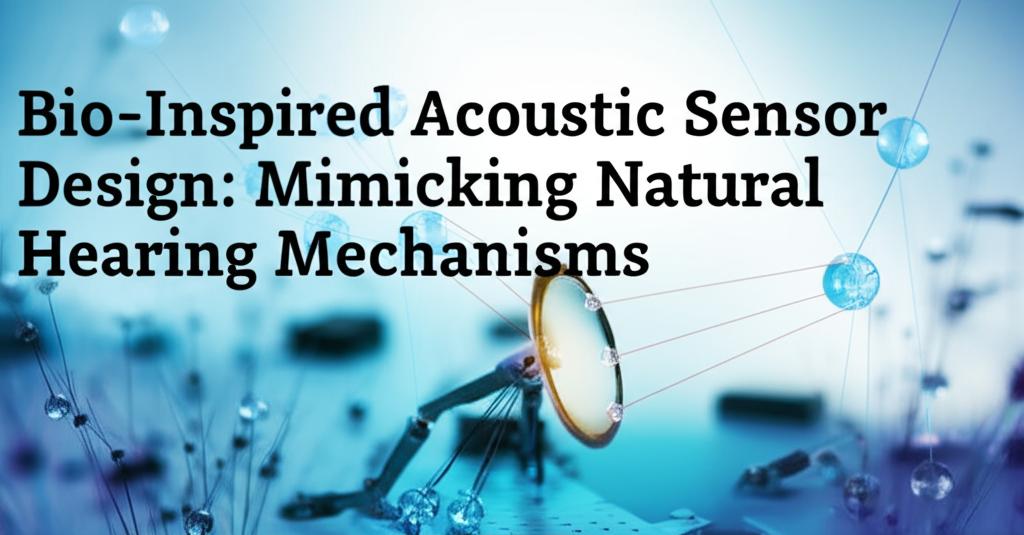Nature is a master engineer, having refined sensory systems over millions of years through evolution. By studying and mimicking the sophisticated mechanisms found in biological hearing, researchers are designing advanced acoustic sensors with capabilities that often surpass traditional technology. This field, known as bio-inspired acoustic sensor design, leverages nature's blueprints to create smaller, more efficient, and highly sensitive devices for a wide array of applications.
Learning from Nature's ExcellenceBiological hearing systems possess remarkable features that engineers strive to replicate:
- Miniaturization and Efficiency: Insects like the Ormia ochracea fly demonstrate exceptional directional hearing despite their minuscule size, achieved through mechanically coupled eardrums that amplify tiny time differences in sound arrival. This inspires miniature microphones for applications like hearing aids where space is limited.
- Sensitivity and Frequency Selectivity: The mammalian cochlea acts like a biological spectrum analyzer, separating complex sounds into different frequencies along its length. It achieves remarkable sensitivity and can detect faint sounds across a wide frequency range (~120 dB). This has led to the development of MEMS (Micro-Electro-Mechanical Systems) cochleas and sensors using materials like piezoelectric films on ultra-thin structures to mimic this frequency decomposition.
- Directionality: Many animals can pinpoint the source of a sound with high accuracy. Bats use sophisticated echolocation, emitting ultrasonic pulses and interpreting the returning echoes to navigate and hunt in complete darkness. This principle guides the design of sonar systems for robotics, autonomous vehicles, and assistive technologies for the visually impaired. The Ormia fly's mechanism is also a key inspiration for directional microphones.
- Adaptability and Noise Reduction: Natural hearing systems excel at picking out relevant sounds in noisy environments (the "cocktail party effect"). Bio-inspired sensors are being developed with adaptive capabilities, using feedback mechanisms to adjust their sensitivity and linearity in response to changing acoustic conditions, improving signal detection in noise.
- Low Power Consumption: Biological systems are incredibly energy-efficient. Mimicking these processes allows for the creation of sensors, particularly MEMS devices, that require minimal power, suitable for wearables, implants, and long-term monitoring applications.
Several biological models stand out:
- Human Cochlea: Inspires sensors that sort frequencies using graded structures, often employing piezoelectric or piezoresistive materials on flexible membranes or within MEMS structures. Recent developments include bio-inspired soft elastic metamaterials (BSEMs) aiming to replicate the cochlea's shape and function more closely, potentially offering high frequency resolution without significant power needs. Active sensing mechanisms, mimicking the cochlea's ability to amplify quiet sounds, are also being explored.
- **Ormia ochracea Fly: The mechanical coupling between its eardrums allows it to determine sound direction with precision far beyond what its small size would typically permit. This drives the design of differential MEMS microphones optimized for directionality and low noise, particularly relevant for hearing aids.
- Bats: Their echolocation system inspires ultrasonic sensors and sonar systems for distance measurement, obstacle avoidance, and 3D imaging, especially in conditions where cameras or LiDAR might fail (e.g., fog, dust). Researchers have even developed artificial sonar "signposts," inspired by how certain flowers reflect bat sonar, to aid robot navigation.
- Other Models: Fish lateral lines inspire underwater vector hydrophones (often using cilia-like MEMS structures), while spider webs and silk have inspired sensors for detecting minute vibrations and airflow.
These inspirations are realized using various technologies, including:
- MEMS Technology: Allows for the miniaturization and mass production of complex sensor structures like cantilevers, membranes, and cilia.
- Piezoelectric Materials (e.g., PZT, AlN): Generate electrical charge in response to mechanical stress (sound waves), enabling self-powered or low-power sensing.
- Piezoresistive Materials: Change electrical resistance under mechanical strain, often used in conjunction with biomimetic structures.
- Capacitive Sensing: Detects changes in capacitance caused by the movement of a diaphragm relative to a backplate due to sound pressure.
- Optical Sensing: Uses light to detect the minute mechanical vibrations of sensor components, potentially offering very low noise floors.
- Acoustic Metamaterials: Artificially engineered materials designed to control, direct, and manipulate sound waves in ways not found in conventional materials, sometimes inspired by cochlear structure.
- Flexible Electronics: Enables the creation of sensors that can conform to curved surfaces, suitable for wearables and biomimetic designs mimicking soft biological tissues.
Applications Across Diverse Fields
The innovations in bio-inspired acoustic sensors are paving the way for advancements in numerous areas:
- Healthcare: Next-generation hearing aids with improved directionality, noise reduction, and natural sound quality; cochlear implant alternatives; advanced electronic stethoscopes; wearable sensors for monitoring vital signs like heart and breathing sounds.
- Robotics and Autonomous Systems: Enhanced navigation and environmental perception for robots and self-driving cars, especially using sonar in challenging conditions; improved human-robot interaction through better voice recognition.
- Consumer Electronics: More sophisticated microphones for smartphones, smart speakers, and virtual assistants with better noise cancellation and directionality.
- Industrial Monitoring: Detecting machine faults through characteristic sound signatures; quality control applications.
- Environmental and Marine Monitoring: Low-power, long-duration underwater acoustic monitoring (hydrophones) for studying marine life or tracking underwater vehicles; airflow sensors.
- Security and Defense: Acoustic surveillance systems; distributed sensor networks.
- Human-Machine Interaction: Voice user interfaces (VUIs) with improved robustness and accuracy, potentially using machine learning combined with sensor data for biometrics (speaker identification).
The Future is Listening**
The field of bio-inspired acoustic sensor design continues to evolve rapidly. Current research focuses on integrating sensing with processing (neuromorphic approaches), enhancing adaptability in real-world noisy environments, further reducing power consumption, combining multiple sensing modalities (like acoustic and tactile), and leveraging machine learning and AI to interpret complex acoustic data more effectively. By continuing to draw inspiration from the intricate and efficient solutions found in nature, engineers are poised to create acoustic sensors with unprecedented performance and capabilities.

